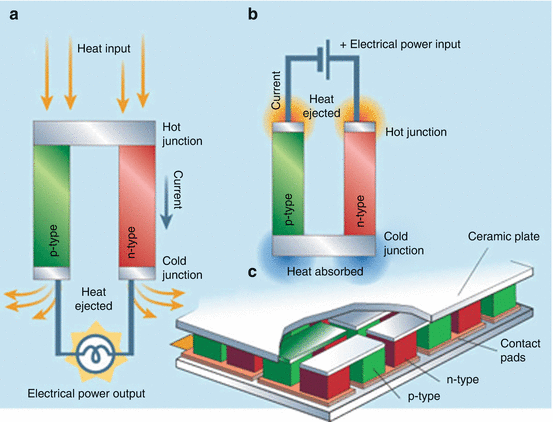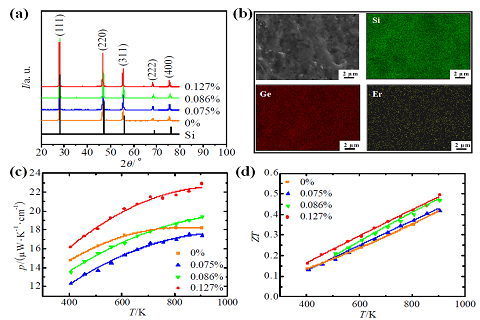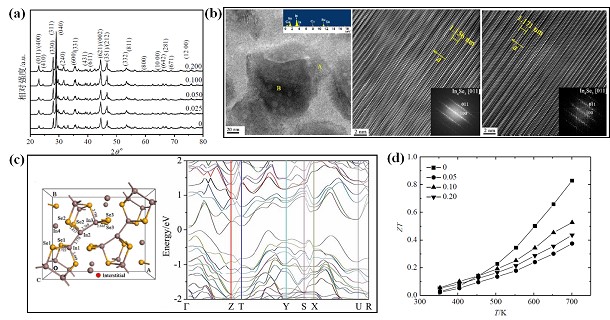Thermoelectric materials, which capable of directly convert waste heat of electricity, were regarded as a new clean energy material. Thermoelectric materials were first used in daily life such as refrigerator refrigeration, and then developed into aerospace and military fields to provide electrical energy for space probes. In recent years, new compounds with high thermoelectric figure of merit have also been emerging. The high ZT of thermoelectric materials in the medium and high temperature zone is approximately 1.5, which makes it possible to the application of waste heat power generation in thermoelectric technology. However, how to coordinate and optimize the transport performance of carriers and phonons, so as to improve the energy conversion efficiency of thermoelectric materials, and to make them play a greater application value in the use of waste heat for power generation is the main goal of the researchers. At present, high performance thermoelectric materials are mostly composed of toxic or expensive elements such as Pb, Te, and Bi, and their large-scale application can bring adverse effects on the environment.

Beautiful image adapted from: Zhou M., He J. (2012) Nanostructured Thermoelectric Materials. In: Bhushan B. (eds) Encyclopedia of Nanotechnology. Springer, Dordrecht. https://doi.org/10.1007/978-90-481-9751-4_59
Beautiful image adapted from: Zhou M., He J. (2012) Nanostructured Thermoelectric Materials. In: Bhushan B. (eds) Encyclopedia of Nanotechnology. Springer, Dordrecht. https://doi.org/10.1007/978-90-481-9751-4_59
In response to the above problems, the research group creatively proposed the concept of structural control and prepared a series of environmentally friendly thermoelectric materials at medium and high temperatures, such as SiGe-based thermoelectric materials, In4Se3-based thermoelectric materials, Cu2S-based thermoelectric materials, etc. This strategy could optimize the thermoelectric properties of thermoelectric materials. Meanwhile, the influence of microstructure regulation on the energy band structure of the material is analyzed through first-principles calculations. The following areas are the main focus of the research group:
(1) SiGe alloy has promising development prospects of high-temperature thermoelectric material due to its high melting point, narrow band gap, and low thermal conductivity. However, the material can produce segregation and other problems in the traditional preparation process. To better solve those challenges, the P-type Si80Ge20B0.6Ery alloy was prepared by mechanical alloying combined with spark plasma sintering technology, and the thermoelectric properties of B and rare earth element Er on the SiGe alloy were initially explored.

(a) XRD patterns for samples with different amount of Er addition; (b) Mapping of fracture surface for the sample with 0.127% Er addition; (c) Temperature dependence of power factor for samples with different amount of Er addition; (d) Temperature dependence of ZT for samples with different amount of Er addition.
(2) The complex crystal structure of In4Se3 has a high Seebeck coefficient and extremely low thermal conductivity. However, in view of the low conductivity of its material, the research group explored Cu intercalation doping, Ag doping and rare earth element doping (Ce, Cd). Different forms of doping methods were used to improve the electrical transport performance of In4Se3-based thermoelectric materials, which was aimed to obtain the influence of doping concentration on the thermoelectric properties of the material. In addition, an accelerated experiment was designed to evaluate the thermal stability of the In4Se3 material at the service temperature, which proved that the material has a relatively stable electric heating transport performance.

(a) XRD patterns for specimens In4CuxSe3; (b) TEM images of specimen In4Cu0.050Se3; (c) Crystal structure and Energy band structure of Cu-intercalated specimen In4Cu0.25Se3; (d) Temperature dependence of ZT for specimens In4CuxSe3.
(3) Cu2S have received tremendous attentions in the thermoelectric field due to the superior performance, non-toxic, environmental protection, and low cost as medium-temperature thermoelectric material. Due to the poor structural controllability of the powder prepared by melting method, the research team started by improving the electrical properties and changing the structure, using a low-cost, small particle size and flexible control of the hydrothermal technology route. Moreover, a strategy for synergistic optimization of thermoelectric performance with nano-composite structure and element doping (Ag, Ni) was also under investigation.

(a-d) TEM image of Ag/Cu2S sphere and corresponding element mappings of Ag/ Cu2S sphere. (e) Temperature dependence of ZT for specimens In4Se3 for sintered samples; (f) Comparison of ZT and power factors of Cu2S based materials in this work and previous reports. The columns with different colors in (f) stand for the power factor and ZT of Cu2S-0.5 wt% Ag of the current work.
Representative Publications:
[1] R. Zhao, L. Shen, F. Guo. Enhanced electrical conductivity in Si80Ge20B0.6 alloys with Er addition prepared by spark plasma sintering. Journal of Materials Research, 2011, 26(15):1879-1885.
[2] Y. T. Shu, R. Zhao, F. Guo, et al. Improvement of thermoelectric properties via combination of nanostructurization and elemental doping. JOM, 2014, 66(11): 2298-2308.
[3] R. Zhao, Y. T. Shu, F. Guo. Enhanced thermoelectric properties of N-type polycrystalline In4Se3-x compounds via thermally induced Se deficiency. Functional Materials Letters, 2014, 7(3):965-968.
[4] 赵然, 沈丽, 张忻, 路清梅, 郭福. 放电等离子烧结制备Si80Ge20B0.6合金及其热电性能. 功能材料, 2011, 42(S3):468-469.
[5] 赵然, 马立民, 郭福, 胡扬端瑞, 舒雨田. 高优值系数 In4Se3 多晶的制备及热电输运特性. 无机材料学报. 2015, 30(3): 249-255.
[6] K.F. Hsu, S. Loo, F. Guo, et al., Cubic AgPbmSbTe2+m: Bulk Thermoelectric Materials with High Figure of Merit, Science, 2004, 303:818.
